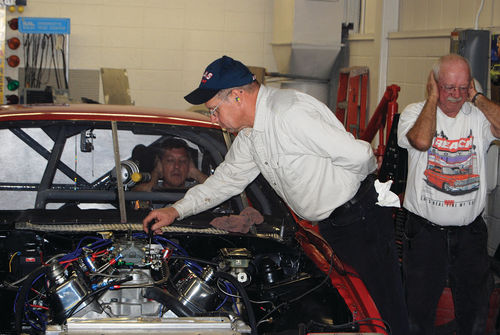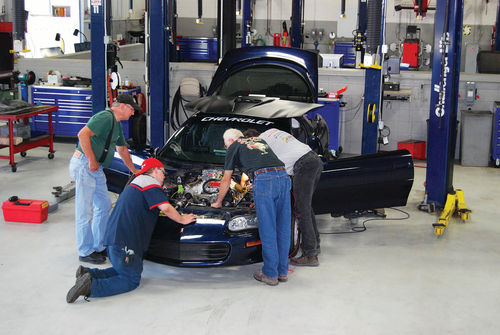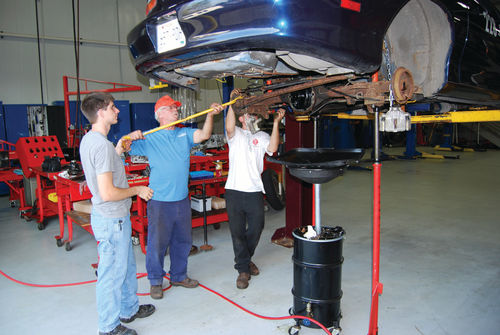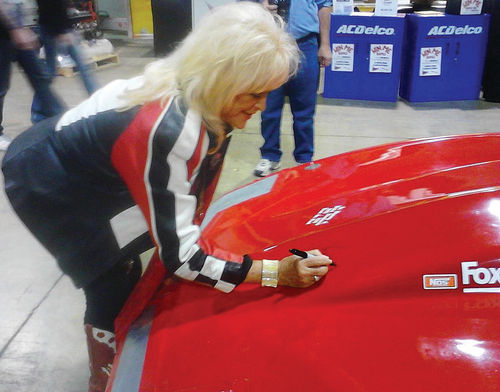Diary of a Salt Flats Racer, Pt. 1
The Lure of Driving Flat Out at Bonneville Is a Strong One. Let’s Join Some Young and Older Motorheads There.
DAVE SARNA WALKED into my office last May and threw a DVD case on my desk. On the label was a picture of actor Anthony Hopkins and the logo of the movie “World’s Fastest Indian.” That film tells the story of New Zealander Burt Monro who set records with an Indian motorcycle at the Bonneville Salt Flats in the 1960s. Munro was 68 and riding a 47-year-old machine when he set his last record in 1967.
“You’re going to Bonneville with me!” Sarna said. His terse statement was the start of a journey that exactly five months later would have me lying under a Pontiac Firebird in Northwestern Utah helping a bunch of old hot rodders and about a half-dozen “Gearheads Under 30” rebuild a rear axle on the Salt!
Answering the Call of the Salt
Now, back to Dave Sarna. We met when he briefly left teaching to sell magazine advertising. Dave didn’t stay in the advertising business very long and ultimately went back to sharing his automotive technology skills with students at Fox Valley Technical College (fvtc.edu) in Appleton, Wisconsin.
In his spare time, Dave rebuilt engines (like the one in my ’36 Pontiac), raced snowmobiles, taught Ford techs in Dearborn, Michigan, competed in the Great American race, served three combat tours in Iraq and Afghanistan, again returned to teaching and started a “Beat the Heat” kids-versus-cops drag racing program for Fox Valley Technical College students and local high school kids.

The Northeast Wisconsin Beat the Heat chapter was comprised of students, police officers, tech and high school instructors and adult volunteers. They built an ’86 Firebird that ran the entire Hot Rod Power Tour on E85 fuel. Students raced the car at Wisconsin International Raceway in Kaukauna on specially designated High School Drag Nights during the summer.


Then Sarna got the idea to take cars, students and volunteers to Bonneville.
Between April and July, Sarna’s invitation to take a once-in-a-lifetime vacation seemed almost like a vision. Then August rolled around and he called me. “We’re having a work night at FVTC,” he said. “Be there at 7 p.m. on Tuesday.”
That was the first of several loosely organized evening sessions during which a bunch of old salts and a group of young “shakers” got a bright red Firebird and a dark blue ’91 Camaro ready to race at the Salt Flats.
About Those Two Cars…
The Firebird had a GM LT1 V-8, a beefed up THM 350 transmission, a full roll cage, a parachute, a nitrous oxide system, racing tires, racing wheel covers and a Ford 9-inch rear axle. The Camaro had a stock V-8, stock tranny and some suspension upgrades.
Dave hoped to drive the Firebird over 200 mph. The Camaro was mostly for the younger members of the team to qualify for the 130-mph class. By the end of the trip, the Firebird would go the fastest it ever had, but break. Every person that drove the Camaro got his 130-mph Bonneville license.
A Little Bit About Bonneville
The Utah Salt Flats Racing Assoc. (saltflats.com) organizes the “World of Speed” that’s held early each September. The World of Speed, with its broad selection of racing vehicles, offers enthusiasts the opportunity to “run what you brung.” They can also compete with purpose built racing cars. Street cars, such as the FVTC Camaro, can compete on the Short Course, a 3-mile straightaway where the 130-mph and 150-mph timing is done. Off to the left is the Long Course, a 7-mile straightaway where the cars going faster than 150 mph are run.
Bonneville records are set by making qualifying runs in excess of an existing record. If your car sets a record, you have one hour to get to an impound area 31 ⁄2 miles from the starting line. While the car is in the impound area, fluids can be checked and general maintenance is allowed…under the watchful eyes of officials. The next morning a second run is made and the average of the two runs, if in excess of an existing record, becomes the new record.
To get a license to drive at Bonneville, each new driver and vehicle must demonstrate an ability to maintain stability through each licensing category. The driver’s license requirements are as follows: Category E requires a valid state driver’s license. Category D is for 125 to 149 mph. Category C is for 150 to 174 mph. Category B is for 175 to 196 mph. Category A is for 200 to 249 mph. The Unlimited category is for drivers who go 300 mph and faster.
Each car gets a racing number and class designation letters.
For instance, a 1964 Tempest wearing No. 766 ran in A/CGALT class. The letter to the left of the slash (AA through K) indicates the engine size range.
The A on the Tempest indicates a 440- to 500-cid engine. There are 11 engine class breaks from AA for over 501 cid down to J (31 to 45 cid), which usually is for motorcycles.
The Class Designation letters used after the slash are B for blown; C for classic, F for fuel, G for gas, M for modified, V for vintage, S for streamliner, L for Lakester, R for roadster, 2Rs for rear engine, STR for street, CC for competition coupe, ALT for altered, S for sport, P for pickup, PRO for production, PS for production supercharged, GT for grand touring and DT for diesel truck. Combining the letters creates the class name. The Tempest, therefore, would be A/Classic Gas ALTered.
Cars—as well as safety gear—must go through a technical inspection prior to making a run.
Then you drive or tow it 31 ⁄2 miles to the starting line and wait your turn to make a run. It can take hours of waiting before you get your chance to assault the Salt. After shut down, it takes a while to get the car back to the pits, which are in the tech inspection area. If you decide to run the same car again, you have to go through Tech again. If you change drivers, the car has to have a different number and go to Tech again.
Entering and running a car at the World of Speed in September is relatively easy. Hitting certain speed goals or attempting to set new records is where the challenge really comes in. The nice thing is that most salt flats racers think of themselves as a community and are willing to share different tweaks and ideas with neighbors who ask.
So, if you want to go faster—or even if you need to score some gear or a part that you broke—asking the car owner next door for help will probably work and you’ll soon be part of the fraternity. You can start by contacting the Utah Salt Flats Racing Assoc. at PO Box 27365, Salt Lake City, UT 84127-0365; saltflats.com; .
First Some Prep…Then on to Utah
Both of the FVTC cars were signed up for the World of Speed and after four or five work nights, both vehicles seemed ready to race.
After cleaning up the school shop, the cars were loaded on trailers and cinched down. It was dark, every crew member—young or old—was tired and the Bonneville Salt Flats were thousands of miles away. The next morning most of the crew would start West on a long trip that proved anything but uneventful. One student named Ross who couldn’t leave his Toyota dealer job early was to fly out with Dave and myself.
Departure day was September 7. The young man—actually a former FVTC student—was waiting at Austin Straubel Field in Green Bay, Wisconsin. But where was our leader? It turns out Dave Sarna was at a body shop an hour away chasing down the loan of a driving suit required at Bonneville. Somehow this was all handled in time and Dave made the plane. We connected with a Salt Lake City flight in Minneapolis. In Salt Lake we picked up two rental cars—in different locations—and then set out for Wendover, about 120 miles away.


Wendover is a Stateline city, with half of it in Utah and half in Nevada. When we arrived, the college’s bright red enclosed trailer was in the parking lot next to the open trailer used to haul the Camaro. That was a positive sign, though we later discovered that the trailers had suffered flat tires on the trip west, and the flat tires would not be the only breakdowns that week!
Luckily our talent pool—both the youthful and veteran components— proved themselves up to the challenges confronting Bonneville racers.
Next time: Racing and wrenching on The Salt.
















